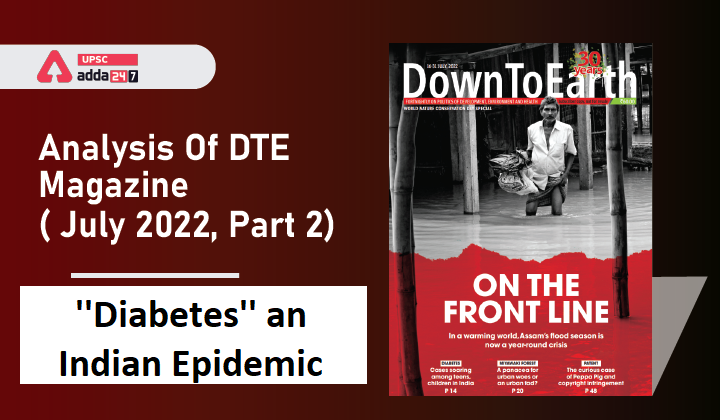Table of Contents
Down To Earth Magazine is a fortnightly magazine focusing on politics of environment and development, published in New Delhi, India.
UPSC Previous years’ questions on Development, Environment, Health and Disaster Management give us a clear idea about the increased importance of Down To Earth Magazine.
Down To Earth Magazine is one of the most important and indispensable source for UPSC Civil Services Exam Preparation. Keeping this in mind, here, we come with ”Gist Of Down To Earth Magazine” which covers important environmental current affairs articles in smooth pointed form, keeping in mind the demand of UPSC aspirants.
”Diabetes” an Indian Epidemic: Introduction
- India has the highest estimated prevalence of Type 1 diabetes in people under 20 years (229,400), followed by the US (157,900) and Brazil (92,300).
- While India adds an estimated 24,000 new cases each year, the US adds 18,200 and Brazil 8,900.
- This is a major shift from the trend five years ago, when India was second to the US. IDF’s Diabetes Atlas for 2017 records 128,500 cases of under-20 Type 1 diabetes in India, with 16,800 new cases annually, as against the US’ 169,900 total cases and 17,100 new cases a year.
”Diabetes” an Indian Epidemic: What is Diabetes?
- The disease is a dysfunction in the body’s regulation of blood-sugar levels and comes in two varieties.
- Type 1 is rare and usually shows up early in life. In this autoimmune disease, the body attacks the cells in the pancreas that produce insulin, a hormone that helps in the use of glucose for energy. Patients must administer insulin for up to four times a day.
- Type 2 is far more common in adults but tends to develop when the body cannot regulate its use of insulin or resists the hormone.
- Obesity and an inactive lifestyle are the most common causes of Type 2. It can usually be controlled with pills and lifestyle changes. Both types, if not treated well and in time, can cause complications like organ failure, blindness, strokes and heart attacks.
”Diabetes” an Indian Epidemic: Why India is Called the Diabetes Capital Of the World?
- India is often referred to as the diabetes capital of the world. But over the past decade, cases of both Type 1 and Type 2 diabetes have seen an increase among children and adolescents.
- There are currently 95,600 cases of Type 1 diabetes among children under 14 years of age, with nearly 16,000 new cases added every year(ICMR).
”Diabetes” an Indian Epidemic: How has Covid-19 Affected Our Fight Against Diabetes?
- Covid-19 has also been a big factor for the rise in Type 1 diabetes cases since the onset of the pandemic.
- Research shows that the sars-cov-2 virus can destroy insulin-producing cells. But the impact is greater than anticipated.
- Before the pandemic, most diabetes hospitals would see one-two new patients every month. This has now increased to two-three new patients every week.
- A January 2022 study by the US Centers for Disease Control and Prevention says, “Persons aged less than 18 years with covid-19 were more likely to receive a new diabetes diagnosis more than 30 days after infection.”
”Diabetes” an Indian Epidemic: Rising Prediabetes is a Great Concern
- While it is likely 5-7 per cent of those under 25 will have diabetes, the number of prediabetic cases may be more than double, and will convert to diabetes in three or four years.
- Prediabetes is a condition wherein the patients blood glucose level is higher than normal—100 to 125 mg/dL, above which it converts to diabetes.
- Prediabetes can be identified only for Type 2 diabetes. Overall, one in 10 children in India is prediabetic, as per the Comprehensive National Nutrition Survey (2016-18) by the Union Ministry of Health and Family Welfare, UN Children’s Fund (UNICEF) and Population Council.
Conclusion
Childhood and adolescent obesity is not taken up seriously in South Asian countries, due to which there is a steady rise in Type 2 diabetes in these age groups and a comprehensive national plan is the need of the hour to overcome this.




 TSPSC Group 1 Question Paper 2024, Downl...
TSPSC Group 1 Question Paper 2024, Downl...
 TSPSC Group 1 Answer key 2024 Out, Downl...
TSPSC Group 1 Answer key 2024 Out, Downl...
 UPSC Prelims 2024 Question Paper, Downlo...
UPSC Prelims 2024 Question Paper, Downlo...





